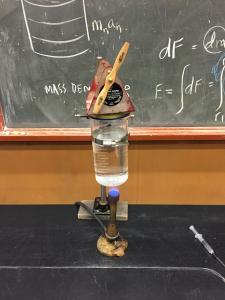Operating Sterling cycle engine, hot water powered.
Primary tabs
Model of a Stirling engine works with both ice and hot water. In 1816, Reverend Robert Stirling invented _a new type of air engine with economizer_ that was safer and more efficient than the steam engines of his day. A Stirling engine with a _regenerator_ (or _economizer_) has a cycle that matches the Carnot cycle. It has the same theoretical maximums and the same theoretical efficiencies. The word _regenerator_ means that some of the heat that is used to heat the air for one cycle is saved and used again in the next cycle. In this model, the regenerator is the yellow piece of foam inside that moves the air from the hot side to the cold side. When the yellow foam inside the engine is near the top of the cylinder (and the engine is running on a cup of hot water) most of the air is on the bottom side (the hot side) where it is heated. When the air gets hot it expands and pushes up on the piston. When the foam moves to the bottom of the engine it moves most of the air (it displaces the air) to the top of the engine. The top of the engine is cool, allowing the air inside the engine to cool off (reject heat to the environment), and the piston receives a downward push. This engine would run even if the _displacer_ (yellow foam) was made of solid Styrofoam. It runs much better because it is made of a special air filter foam. When the air makes the return trip to the hot side of the engine it once again flows through and around the foam. This time the air heats up and the foam cools off. The heat that would have been wasted in an engine without regeneration is saved and a much more efficient is the result. Using Ice: Pick up the engine and rub an ice cube on the bottom. Then place the engine on a bowl filled with ice. Start the propeller with a clockwise twist. When running the engine in a room that is 72 to 75 F, the temperature of the top of the engine will drop to about 68 F. Warm fingertips can be placed over the LCD thermometer area, and within 20 seconds one will see an increase in the operating speed of the engine. Using Hot Water: Water is a very good thermal transfer medium. Fill a beaker about 1/3 full of boiling water. Then set the Stirling Engine on top. If necessary, start the engine by giving the propeller a counter-clockwise twist. The engine should start immediately and run at a high speed. FLUID DYNAMICS.
UCB Index:
C+22+15
PIRA Index:
4F30.10
Demo Picture:

UCB Taxonomy:
PIRA Taxonomy:
Video:
Popularity:
- Log in to post comments

